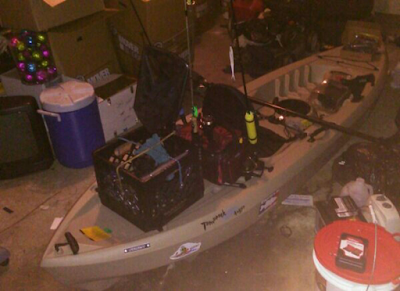We've all been there at some point. You're sitting out on the water (it could be freshwater or saltwater) having a good day, when all of a sudden, a careless boater (or, jet skier), maybe a rogue wave flips you over, and the gear you've been storing in your gear basket behind your seat becomes dislodged from its confines. Maybe, some of it floats? Other items? Not so much.....
Fortunately, you had a cover on it........., right??? You did remember to put a cover on your basket, right? No? Uh oh! Looks like you need to start thinking about a cover that will stay on and keep your gear where it's supposed to be!
Over the years, I've seen some pretty good gear basket designs, and other designs, not as much went into thinking, that the average kayak angler would never think of flipping, or rolling over. It doesn't matter if it's freshwater, or saltwater, there will always be an uncertain future when it comes to an unexpected rollover. Because, no one anticipates a rollover. I would think that's the last thing we want to happen out on the water. For one, it's embarrassing. Number two, it's even more embarrassing trying to get back in your kayak, and lastly, collecting all the items floating on the water - which are scattered all over the place.
Of course, not everything floats - your anchor, some lures, maybe your long nose pliers, sunglasses, etc.. It would be a shame that the cost of everything you packed your gear basket with, was suddenly lost at the bottom of whatever you're fishing on - a lake, a pond, a river, or even the ocean floor.
Now, let's take a look at some gear crate designs that some people thought were "good enough" for their uses. The following photos are used for reference only. I'm using these as future references for how to set up your gear crate properly so you don't end up looking like a fool out on the water.
These 3 photos are all from the same poster on the Kik Messenger #kayakfishing chat room. He is a beginner kayak angler, and this was his first attempt at "dialing it in" on his first SOT kayak.
Photos 1 & 3 show a pretty cluttered area behind the seat. But, the first thing that caught my attention was the two bungee cords crisscrossed over the top of the crate. Really? Do you think this is a good idea in the event of a rollover?
Photo #2, the clearest photo of the group, shows a lot of "technical" items on the front of the crate - (1 pr.) scissors, (3 prs.) pliers, and (1) knife. Hope he didn't pay a lot for all those items! Notice he has a leash for his kayak handle, but not for any of the items on the crate! I can also see he put foam floats zip-tied to his fishing poles. I can honestly say that those foam float tubes aren't buoyant enough to keep your rods afloat. Those poles, and gear crate, each need to be leashed as well!
Here's another example of a gear crate with a top. It's a very simple design, but the top cover needs more "hinges" on it. Those green zip-ties aren't going to hold up well in the summer sun. The sun's ultraviolet rays will dry rot those zip-ties in a hurry. There should be at 10 -12 zip-ties across to hold that cover in place. If one or two zip-ties break, there will be plenty more to keep the lid shut should you rollover. Not exactly sure how it stays shut, though.....
The next photos are of my old "prototype" gear crate. I was on another kayak fishing forum site, and adapted my own tricks to the forum leader's crate idea. I added acrylic plastic panels to the top cover, and the inside top box bottom. I also added a holster for my lip grippers and used an old phone cord acting as a leash to keep it in place. I also added reflective tape on the top box so that people using a searchlight will see the kayak better at night, or in foggy conditions.
On the front of the crate, I added a Scotty Mount for my mast with safety flag. The mast also has reflective tape near the top for better visibility at night or in dense fog. I also added cheap plastic kitchen cabinet knobs to hold both the lid, and top box in place should you rollover. The strength of the mini bungee cords was strong to hold a 2.5 lb. weight in place ensuring the items inside would not be lost. On the inside of the lower crate, I added a piece of 1" foam on the bottom, so when you return a storage box back on the inside, the sound doesn't scare the fish away with a loud clunk. The foam at the bottom will provide a cushion for your storage boxes.
So, with that said, if you don't want to lose it, you can either leash it, lash it down, or lose it. It's your wallet. You have to decide for yourself on how much you're willing to spend, and if you feel the need to spend more on quality stuff, or build it yourself, and save a few bucks.
For more info on how to build a quality gear basket, go here:







No comments:
Post a Comment